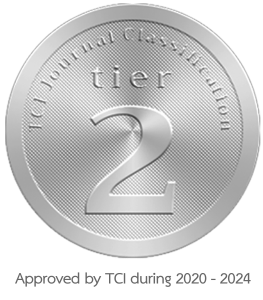Judgements of EFL Students on English Stress Placement
DOI:
https://doi.org/10.14456/jel.2023.16Abstract
The purposes of the study were to investigate the knowledge related to the stress in English at the word level and the sentence level gained by 2nd – 4th year Thai students majoring in English and to compare the scores of the knowledge test obtained by the students with different years of their study and different faculties of their affiliations. The randomly selected sample consisted of 190 participants out of 321 volunteers, the 2nd - 4th year English majors. The research instrument was a Test to Measure the Knowledge of English Stress (TMKES) at the word and sentence levels used to collect the data, and the statistics that were utilized to analyze the data included frequency, mean, standard deviations, and One-Way ANOVA. The findings of the study showed that students who took the test were able to score over half of the total on average. The students’ competence in English stress was not significantly different due to their different years of study. However, the students who were affiliated with different faculties had the significantly different competence in English word stress excluding English sentence stress. Additionally, when the scores of both the word stress and the sentence stress were combined, there was a statistically significant difference owing to the distinguishable affiliations.
References
Ahmed, L. (2019). Pronunciation problems of words’ stress placement in English by Saudi students at Albaha University, Saudi Arabia. A case study at Almandag. International Journal of Applied Linguistics & English Literature, 8(6), 103-113.Cabrera, L. R. (2016). English speaking and pronunciation competence in students of Suan Sunantha Rajabhat University. International Conference on Management Science, Innovation, and Technology(1 -13). Suan Sunandha Rajabhat University. http://icmsit.ssru.ac.th/icmsit/fmsicmsit1/images/2016/icmsit2016-1.pdf Carley, P., Collins, B., & Mees, I. M. (2019). Practical English phonetics and phonology(4th ed.). Routledge.Carr, P. (2013). English phonetics and phonology: An introduction (2 nd ed.). Wiley- Blackwell. Chatuphot, M., & Kasuwan, M. (2013). Effectiveness of English song activities on learning and retention of vocabulary and speaking skills. Journal of Liberal Arts, Prince of Songkla University, 5(2), 17-31. Cruttenden, A. (1986). Intonation. Cambridge University Press.Ghaemi, F., & Rafi, F. (2018). The impact of visual aids on the retention of English word stress patterns. International Journal of Applied Linguistics and English Literature, 7(2), 225-231. Jarosz, A., & Sadegna, V. G. (2022). Exploring how YouGlish supports learning English word stress: A perception study. In V.G. Sardegna & A. Jarosz (Eds.), Theoretical andpractical developments in English speech assessment, research, and training: Studies in honour of Ewa Waniek-Klimczak (pp. 165-184). Springer Cham.https://dx.doi.org/10.1007/978-3-030- 98218-8 10Kansakar, T. R. (1998). A course in English phonetics. Orient Longman.Katz, W. F. (2013). Phonetics for dummies. John Wiley & Sons. Khamkhien, A. (2010). Thai learners’ English pronunciation competence: Lesson learned from word stress assignment. Journal of Language Teaching and Research, 1(6), 757- 764. Kraiwan, Y. (2002). Basics of research (4 th ed). Suweerayasat.Kuder, G. F., & Richardson, M. W. (1937). The theory and estimation of test reliability. Psychometrika, 2, 151- 160. Orion, G. F. (2012). Pronouncing American English (3rd ed.). Heinle.Panthong, N., & T umtavitikul, A. (2015). Syllable stress and vowel reduction in unstressed syllables in the bilingual school students’ English language. https://opac02.rbru.ac.th/cgi-bin/koha/opac-detail.pl?biblionumber=2260 Roach, P. (2009). English phonetics and phonology (4 th ed.). Cambridge University Press.Rogers, H. (2000). The sound of language: An introduction to phonetics. Routledge.Rogers, U. (2013). Thai English as a variety (Doctoral dissertation). https://repository.asu.edu/attachments/110689/content/Rogers_asu_0010E_13107.pdfRovinelli, R. J. ( 1976). Methods for validating criterion-referenced test items. (Unplblisded Doctoral Dissertation).https://scholarworks.umass.edu/cgi/viewcontent.cgi?referer=https://www.google.Co.th/&httpsredir=1&article=4661&context=dissertations_1
Saenglor, K. (2017). Development of e-learning lessons in English for communication based on the contexts. Journal of Educational Research Faculty of Education Srinakharinwirot University, 1(1), 286-299. Theppanya, P. (2014). Using semantically relative mapping activities to enhance English reading ability and to increase the retention of undergraduates’ vocabulary memory. Phikhanetsan,10(1), 149-158. Tolibovna, Y. Z. (2023). Importance of teaching the pronunciation of suprasegmental features of English. Interanational Journal of Social Science and Interdisciplinary Research, 12(05) ,32–35. https://www.gejournal.net/index.php/IJSSIR/article/view/1745Topal, I. H. (2022). A review of Tureng: The multilingual dictionary. Journal of Research in Techno-Based Language Education, 2(3),16- 30. https://www.jrtle.ir/article_157271_2374bcfe92dc2b2e8541b7207ae2adb8.pdfYamane, T. (1973). Statistics: An introductory analysis. New York: Harper & Row.Yangklang, W. (2013). Improving English stress and intonation pronunciation of the first year students of Nakhon Ratchasima Rajabhat University through an e-learning. Procedia - Social and Behavioral Sciences, 91, 444 – 452.



















